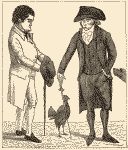|
This
section is listed in approximately chronological order |
|
1. |
|
Edinburgh has a long tradition of book publishing, extending into the 20th century. Early engravers in Edinburgh included: |
|
-
John Clarke (engraving,1690), |
|
-
Richard Cooper (b.1705)
worked with his apprentices |
|
-
Andrew Bell (above)
subsequently worked with his own apprentices |
|
2. |
|
-
David Allan (b.1744,
painter living in Edinburgh from 1780)
|
|
- John Kay (b.1742 Dalkeith; d.1826 Edinburgh) was a miniaturist, caricaturist and engraver. Two large volumes of his caricatures of Edinburgh personalities have been published. Smith and Brodie - after Kay |
|
-
Alexander Robertson (above)
then employed an apprentice, |
|
-
Robert Scott (above)
had sons who took up engraving and etching: |
|
-
James Stewart (also
painter, b.1791), |
|
-
Francis Lamb (born
in Leith, c.1775-1850), |
|
3. |
|
- Walter Geikie RSA (b. Edin 1795, d. Edin 1837) etcher, was also a painter and a draftsman. He became deaf and dumb as the result of a fever |
|
- John Burnet (b. Fisherrow, 1784-1868) was a well respected painter and engraver. He moved to London in 1806, and continued to work until 1860. He produced a number of large engravings after Wilkie (with whom he studied) and some after Turner. The Tate Gallery and National Maritime Museum have his paintings in their collections. |
|
-
William Howison ARSA
(1798-1850 or 1851) |
|
- Robert Charles Bell (b. Edin 1806, d. Edin 1872) served his apprenticeship under John Beugho a the Trustees' Academy. He was father of the painter, Robert P Bell |
|
-
David Lizars (portrait
engraver, d.1812) |
|
- Francis Croll (b. Musselburgh 1827; d. Edinburgh 1854) completed his apprenticeship under Robert Charles Bell. |
[Main sources: Book of the Old Edinburgh Club, Vol 9John C Guy + Prints & Printmaking, Raymond Lister]
|
Engravers and Engraving |
||
A selection of Engravings |
||
